 Map of Sinus Sabaeus quadrangle from Mars Orbiter Laser Altimeter (MOLA) data. The highest elevations are red and the lowest are blue. | |
| Coordinates | 15°00′S 337°30′W / 15°S 337.5°W |
|---|---|
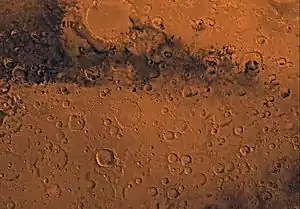
The Sinus Sabaeus quadrangle is one of a series of 30 quadrangle maps of Mars used by the United States Geological Survey (USGS) Astrogeology Research Program. It is also referred to as MC-20 (Mars Chart-20).[1] The Sinus Sabaeus quadrangle covers the area from 315° to 360° west longitude and 0° to 30° degrees south latitude on Mars. It contains Schiaparelli, a large, easily visible crater that sits close to the equator. The Sinus Sabaeus quadrangle contains parts of Noachis Terra and Terra Sabaea.
The name comes from an incense-rich location south of the Arabian peninsula (the Gulf of Aden).[2]
Layers
Wislicenus Crater and the Schiaparelli basin crater contains layers, also called strata. Many places on Mars show rocks arranged in layers.[3] Sometimes the layers are of different colors. Light-toned rocks on Mars have been associated with hydrated minerals like sulfates. The Mars rover Opportunity examined such layers close-up with several instruments. Some layers are probably made up of fine particles because they seem to break up into fine dust. Other layers break up into large boulders so they are probably much harder. Basalt, a volcanic rock, is thought to in the layers that form boulders. Basalt has been identified on Mars in many places. Instruments on orbiting spacecraft have detected clay (also called phyllosilicates) in some layers. Scientists are excited about finding hydrated minerals such as sulfates and clays on Mars because they are usually formed in the presence of water.[4] Places that contain clays and/or other hydrated minerals would be good places to look for evidence of life.[5]
Rock can form layers in a variety of ways. Volcanoes, wind, or water can produce layers.[6] Layers can be hardened by the action of groundwater. Martian ground water probably moved hundreds of kilometers, and in the process it dissolved many minerals from the rock it passed through. When ground water surfaces in low areas containing sediments, water evaporates in the thin atmosphere and leaves behind minerals as deposits and/or cementing agents. Consequently, layers of dust could not later easily erode away since they were cemented together. On Earth, mineral-rich waters often evaporate forming large deposits of various types of salts and other minerals. Sometimes water flows through Earth's aquifers, and then evaporates at the surface just as is hypothesized for Mars. One location this occurs on Earth is the Great Artesian Basin of Australia.[7] On Earth the hardness of many sedimentary rocks, like sandstone, is largely due to the cement that was put in place as water passed through.
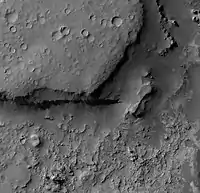 Wislicenus Crater Floor, as seen by HiRISE. Erosion on floor has made layers visible.
Wislicenus Crater Floor, as seen by HiRISE. Erosion on floor has made layers visible. Bouguer (Martian crater) as seen by CTX. Crater rim is at top. Small craters are on floor of the crater.
Bouguer (Martian crater) as seen by CTX. Crater rim is at top. Small craters are on floor of the crater.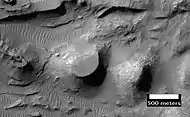 Close up of layers in eroded deposits on the floor of Bouguer Crater, as seen by HiRISE. This image is in a different part of the crater than the previous image.
Close up of layers in eroded deposits on the floor of Bouguer Crater, as seen by HiRISE. This image is in a different part of the crater than the previous image.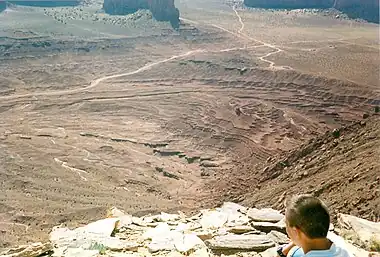 Layers in Monument Valley. These are accepted as being formed, at least in part, by water deposition. Since Mars contains similar layers, water remains as a major cause of layering on Mars.
Layers in Monument Valley. These are accepted as being formed, at least in part, by water deposition. Since Mars contains similar layers, water remains as a major cause of layering on Mars. White layers that may be related to the white material in Pollack Crater, as seen by HiRISE under HiWish program.
White layers that may be related to the white material in Pollack Crater, as seen by HiRISE under HiWish program.
Schiaparelli Crater
Schiaparelli is an impact crater on Mars located near Mars's equator. It is 461 kilometers (286 mi) in diameter and located at latitude 3° south and longitude 344°. Some places within Schiaparelli show many layers that may have formed by the wind, volcanoes, or deposition under water.
 MOLA map of area around Schiaparelli Crater
MOLA map of area around Schiaparelli Crater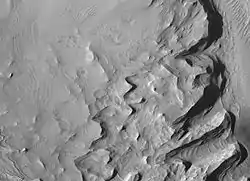 Layers in Crater within Schiaparelli crater, as seen by HiRISE
Layers in Crater within Schiaparelli crater, as seen by HiRISE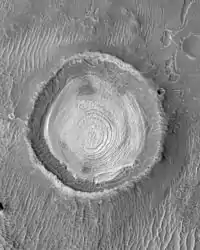 Layers in crater found within the Schiaparelli crater basin as seen by Mars Global Surveyor
Layers in crater found within the Schiaparelli crater basin as seen by Mars Global Surveyor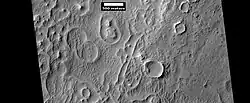 Circular structures on floor of Schiaparelli Crater, as seen by HiRISE under HiWish program
Circular structures on floor of Schiaparelli Crater, as seen by HiRISE under HiWish program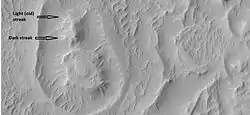 Close-up of circular structure from previous image, as seen by HiRISE under HiWish program Streaks are also visible.
Close-up of circular structure from previous image, as seen by HiRISE under HiWish program Streaks are also visible. Circular structures on floor of Schiaparelli Crater, as seen by HiRISE under HiWish program
Circular structures on floor of Schiaparelli Crater, as seen by HiRISE under HiWish program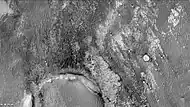 Context view for following picture. Picture taken with CTX.
Context view for following picture. Picture taken with CTX. Wide view of layers in Schiaparelli Crater, as seen by HiRISE under HiWish program Part of the picture is degraded. Parts of this image are enlarged in other images that follow.
Wide view of layers in Schiaparelli Crater, as seen by HiRISE under HiWish program Part of the picture is degraded. Parts of this image are enlarged in other images that follow. Layered mound in Schiaparelli Crater, as seen by HiRISE under HiWish program
Layered mound in Schiaparelli Crater, as seen by HiRISE under HiWish program Layers in Schiaparelli Crater, as seen by HiRISE under HiWish program
Layers in Schiaparelli Crater, as seen by HiRISE under HiWish program Layered mound in Schiaparelli Crater, as seen by HiRISE under HiWish program
Layered mound in Schiaparelli Crater, as seen by HiRISE under HiWish program Layers in Schiaparelli Crater, as seen by HiRISE under HiWish program
Layers in Schiaparelli Crater, as seen by HiRISE under HiWish program Layers in Schiaparelli Crater, as seen by HiRISE under HiWish program
Layers in Schiaparelli Crater, as seen by HiRISE under HiWish program Layers in Schiaparelli Crater, as seen by HiRISE under HiWish program
Layers in Schiaparelli Crater, as seen by HiRISE under HiWish program Close view of layers in Schiaparelli Crater, as seen by HiRISE under HiWish program Dark sand is visible on some layers.
Close view of layers in Schiaparelli Crater, as seen by HiRISE under HiWish program Dark sand is visible on some layers. Close, color view of layers in Schiaparelli Crater, as seen by HiRISE under HiWish program Dark sand is visible on some layers.
Close, color view of layers in Schiaparelli Crater, as seen by HiRISE under HiWish program Dark sand is visible on some layers.
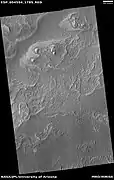 Wide view of layers and rough terrain in Northwestern Schiaparelli Crater, as seen by HiRISE under HiWish program
Wide view of layers and rough terrain in Northwestern Schiaparelli Crater, as seen by HiRISE under HiWish program Close view of layers and rough terrain in Northwestern Schiaparelli Crater, as seen by HiRISE under HiWish program
Close view of layers and rough terrain in Northwestern Schiaparelli Crater, as seen by HiRISE under HiWish program Close view of rough terrain and small pits in Northwestern Schiaparelli Crater, as seen by HiRISE under HiWish program
Close view of rough terrain and small pits in Northwestern Schiaparelli Crater, as seen by HiRISE under HiWish program Close view of rough terrain in Northwestern Schiaparelli Crater, as seen by HiRISE under HiWish program
Close view of rough terrain in Northwestern Schiaparelli Crater, as seen by HiRISE under HiWish program Close view of rough terrain in Northwestern Schiaparelli Crater, as seen by HiRISE under HiWish program
Close view of rough terrain in Northwestern Schiaparelli Crater, as seen by HiRISE under HiWish program
Other Craters
When a comet or asteroid collides at a high speed interplanetary with the surface of Mars it creates a primary impact crater. The primary impact may also eject significant numbers of rocks which eventually fall back to make secondary craters.[8] The secondary craters may be arranged in clusters. All of the craters in the cluster would appear to be equally eroded; indicating that they would all are of the same age. If these secondary craters formed from a single, large, nearby impact, then they would have formed at roughly the same instant in time. The image below of Denning Crater shows a cluster of secondary craters.
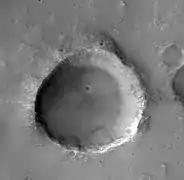 Small crater with material flowing into it, on the rim of Flaugergues Crater, as seen by HiRISE.
Small crater with material flowing into it, on the rim of Flaugergues Crater, as seen by HiRISE.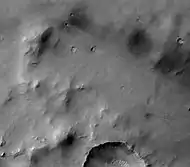 Dawes Crater floor with fresh impact craters, as seen by HiRISE. Click on image to see dark ejecta from some craters that formed when the impact reached a dark layer
Dawes Crater floor with fresh impact craters, as seen by HiRISE. Click on image to see dark ejecta from some craters that formed when the impact reached a dark layer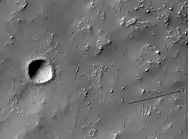 Recent small crater on floor of Dennin Crater, as seen by HiRISE. Arrow shows group of secondary craters from ejecta falling down.
Recent small crater on floor of Dennin Crater, as seen by HiRISE. Arrow shows group of secondary craters from ejecta falling down. Group of secondary craters, as seen by HiRISE under HiWish program
Group of secondary craters, as seen by HiRISE under HiWish program Bouguer (Martian crater) , as seen by CTX camera (on Mars Reconnaissance Orbiter).
Bouguer (Martian crater) , as seen by CTX camera (on Mars Reconnaissance Orbiter). Bakhuysen Crater, as seen by CTX camera (on Mars Reconnaissance Orbiter). Channels are visible on the north (top) and south (bottom) rims of crater.
Bakhuysen Crater, as seen by CTX camera (on Mars Reconnaissance Orbiter). Channels are visible on the north (top) and south (bottom) rims of crater.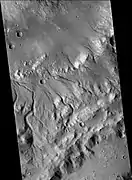 Channels on south rim of Bakhuysen Crater, as seen by CTX camera (on Mars Reconnaissance Orbiter). Note: this is an enlargement of the previous image of Bakhuysen Crater.
Channels on south rim of Bakhuysen Crater, as seen by CTX camera (on Mars Reconnaissance Orbiter). Note: this is an enlargement of the previous image of Bakhuysen Crater. Lambert Crater (Martian Crater), as seen by CTX camera (on Mars Reconnaissance Orbiter).
Lambert Crater (Martian Crater), as seen by CTX camera (on Mars Reconnaissance Orbiter).
Impact craters generally have a rim with ejecta around them, in contrast volcanic craters usually do not have a rim or ejecta deposits. As craters get larger (greater than 10 km in diameter) they usually have a central peak.[9] The peak is caused by a rebound of the crater floor following the impact.[10] If one measures the diameter of a crater, the original depth can be estimated with various ratios. Because of this relationship, researchers have found that many Martian craters contain a great deal of material; much of it is believed to be ice deposited when the climate was different.[11] Sometimes craters expose layers that were buried. Rocks from deep underground are tossed onto the surface. Hence, craters can show us what lies deep under the surface.
White rock in Pollack crater
Within the region is Pollack crater, which has light-toned rock deposits. Mars has an old surface compared to Earth. While much of Earth's land surface is just a few hundred million years old, large areas of Mars are billions of years old. Some surface areas have been formed, eroded away, then covered over with new layers of rocks. The Mariner 9 spacecraft in the 1970s photographed a feature that was called "White Rock.". Newer images revealed that the rock is not really white, but that the area close by is so dark that the white rock looks really white.[3] It was thought that this feature could have been a salt deposit, but information from the instruments on Mars Global Surveyor demonstrated rather that it was probably volcanic ash or dust. Today, it is believed that White Rock represents an old rock layer that once filled the whole crater that it's in, but today it has since been mostly eroded away. The picture below shows white rock with a spot of the same rock some distance from the main deposit, so it is thought that the white material once covered a far larger area.[12]
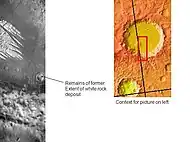 Whiterock on crater floor may be what's left of a much larger deposit. Arrow shows that the deposit once reached much farther. Picture taken by THEMIS.
Whiterock on crater floor may be what's left of a much larger deposit. Arrow shows that the deposit once reached much farther. Picture taken by THEMIS. White Rock in Pollack Crater as seen by HiRISE.
White Rock in Pollack Crater as seen by HiRISE.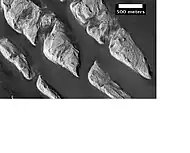 Enlargement of White Rock in Pollack Crater, as seen by HiRISE.
Enlargement of White Rock in Pollack Crater, as seen by HiRISE.
Pollack crater's white rocks:
- White rock in Pollack crater: Mariner 9 (1971-1972)
- White rock in Pollack crater: Viking (1976-1980)
- White rock in Pollack crater: Mars Global Surveyor (1997-2006)
- White rock in Pollack crater: 2001 Mars Odyssey (2001-present)
- White rock in Pollack crater: Mars Express (2004-present)
- White rock in Pollack crater: Mars Reconnaissance Orbiter (2006-present)
Channels in Sinus Sabaeus quadrangle
There is enormous evidence that water once flowed in river valleys on Mars.[13][14] Images of curved channels have been seen in images from Mars spacecraft dating back to the early seventies with the Mariner 9 orbiter.[15][16][17][18] Indeed, a study published in June 2017, calculated that the volume of water needed to carve all the channels on Mars was even larger than the proposed ocean that the planet may have had. Water was probably recycled many times from the ocean to rainfall around Mars.[19][20]
 Winding channel, as seen by HiRISE under HiWish program
Winding channel, as seen by HiRISE under HiWish program Channels, as seen by HiRISE under HiWish program
Channels, as seen by HiRISE under HiWish program Channels, as seen by HiRISE under HiWish program
Channels, as seen by HiRISE under HiWish program Channels, as seen by HiRISE under HiWish program
Channels, as seen by HiRISE under HiWish program
Ridges
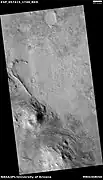 This straight ridge may be a dike that has been exposed by erosion. It was initially formed by magma moving under the surface along weak spots. The picture was taken with HiRISE under the HiWish program.
This straight ridge may be a dike that has been exposed by erosion. It was initially formed by magma moving under the surface along weak spots. The picture was taken with HiRISE under the HiWish program. This long, straight ridge may be a dike that has been exposed by erosion. It was initially formed by magma moving under the surface. The picture was taken with HiRISE under the HiWish program.
This long, straight ridge may be a dike that has been exposed by erosion. It was initially formed by magma moving under the surface. The picture was taken with HiRISE under the HiWish program.
Other scenes from Sinus Sabaeus quadrangle
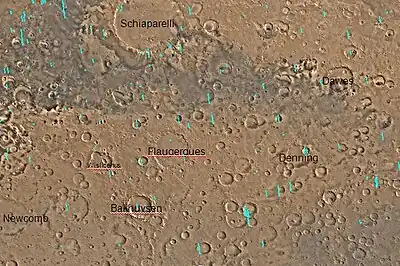 Quadrangle map of Sinus Sabaeus labeled with major features. Colored rectangles represent image footprints of Mars Global Surveyor.
Quadrangle map of Sinus Sabaeus labeled with major features. Colored rectangles represent image footprints of Mars Global Surveyor.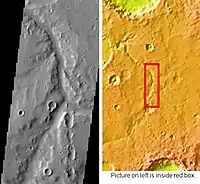 Verde Vallis, as seen by THEMIS.
Verde Vallis, as seen by THEMIS. Dunes, as seen with HiRISE under the HiWish program.
Dunes, as seen with HiRISE under the HiWish program. Wide view of mesas, as seen by HiRISE under HiWish program
Wide view of mesas, as seen by HiRISE under HiWish program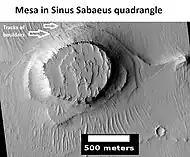
 Close view of mesa, as seen by HiRISE House-sized boulders are present in abundance. This image was named HiRISE picture of the day for November 14, 2023.
Close view of mesa, as seen by HiRISE House-sized boulders are present in abundance. This image was named HiRISE picture of the day for November 14, 2023. Close view of cap rock, as seen by HiRISE The cap rock overhangs some layers. The cap rock was more resistant to erosion, so it formed an overhang.
Close view of cap rock, as seen by HiRISE The cap rock overhangs some layers. The cap rock was more resistant to erosion, so it formed an overhang.
Other Mars quadrangles
Interactive Mars map
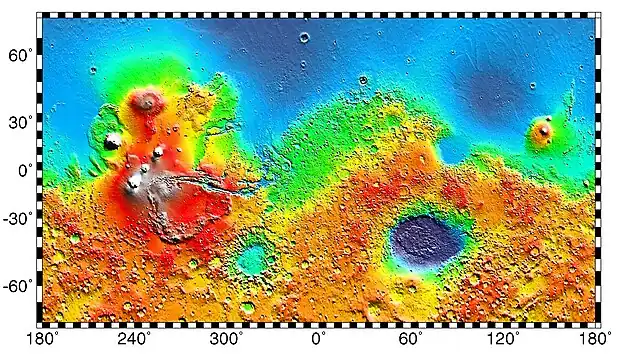
See also
References
- ↑ Davies, M.E.; Batson, R.M.; Wu, S.S.C. “Geodesy and Cartography” in Kieffer, H.H.; Jakosky, B.M.; Snyder, C.W.; Matthews, M.S., Eds. Mars. University of Arizona Press: Tucson, 1992.
- ↑ Blunck, J. 1982. Mars and its Satellites. Exposition Press. Smithtown, N.Y.
- 1 2 Grotzinger, J. and R. Milliken (eds.) 2012. Sedimentary Geology of Mars. SEPM
- ↑ "Target Zone: Nilosyrtis? | Mars Odyssey Mission THEMIS".
- ↑ "HiRISE | Craters and Valleys in the Elysium Fossae (PSP_004046_2080)".
- ↑ http://hirise.lpl.arizona.edu?PSP_008437_1750
- ↑ Habermehl, M. A. (1980) The Great Artesian Basin, Australia. J. Austr. Geol. Geophys. 5, 9–38.
- ↑ "HiRISE | Science Themes: Impact Processes".
- ↑ "Stones, Wind, and Ice: A Guide to Martian Impact Craters".
- ↑ Hugh H. Kieffer (1992). Mars. University of Arizona Press. ISBN 978-0-8165-1257-7. Retrieved 7 March 2011.
- ↑ Garvin, J., et al. 2002. Global geometric properities of martian impact craters. Lunar Planet Sci. 33. Abstract @1255.
- ↑ "Mars: What We Know About the Red Planet". Space.com. October 2021.
- ↑ Baker, V., et al. 2015. Fluvial geomorphology on Earth-like planetary surfaces: a review. Geomorphology. 245, 149–182.
- ↑ Carr, M. 1996. in Water on Mars. Oxford Univ. Press.
- ↑ Baker, V. 1982. The Channels of Mars. Univ. of Tex. Press, Austin, TX
- ↑ Baker, V., R. Strom, R., V. Gulick, J. Kargel, G. Komatsu, V. Kale. 1991. Ancient oceans, ice sheets and the hydrological cycle on Mars. Nature 352, 589–594.
- ↑ Carr, M. 1979. Formation of Martian flood features by release of water from confined aquifers. J. Geophys. Res. 84, 2995–300.
- ↑ Komar, P. 1979. Comparisons of the hydraulics of water flows in Martian outflow channels with flows of similar scale on Earth. Icarus 37, 156–181.
- ↑ "How Much Water Was Needed to Carve Valleys on Mars? - SpaceRef". 5 June 2017.
- ↑ Luo, W., et al. 2017. New Martian valley network volume estimate consistent with ancient ocean and warm and wet climate. Nature Communications 8. Article number: 15766 (2017). doi:10.1038/ncomms15766
- ↑ Morton, Oliver (2002). Mapping Mars: Science, Imagination, and the Birth of a World. New York: Picador USA. p. 98. ISBN 0-312-24551-3.
- "Online Atlas of Mars". Ralphaeschliman.com. Retrieved December 16, 2012.
- "PIA03467: The MGS MOC Wide Angle Map of Mars". Photojournal. NASA / Jet Propulsion Laboratory. February 16, 2002. Retrieved December 16, 2012.
- ↑ "Online Atlas of Mars". Ralphaeschliman.com. Retrieved December 16, 2012.
- ↑ "PIA03467: The MGS MOC Wide Angle Map of Mars". Photojournal. NASA / Jet Propulsion Laboratory. February 16, 2002. Retrieved December 16, 2012.
Further reading
- Grotzinger, J. and R. Milliken (eds.). 2012. Sedimentary Geology of Mars. SEPM.
